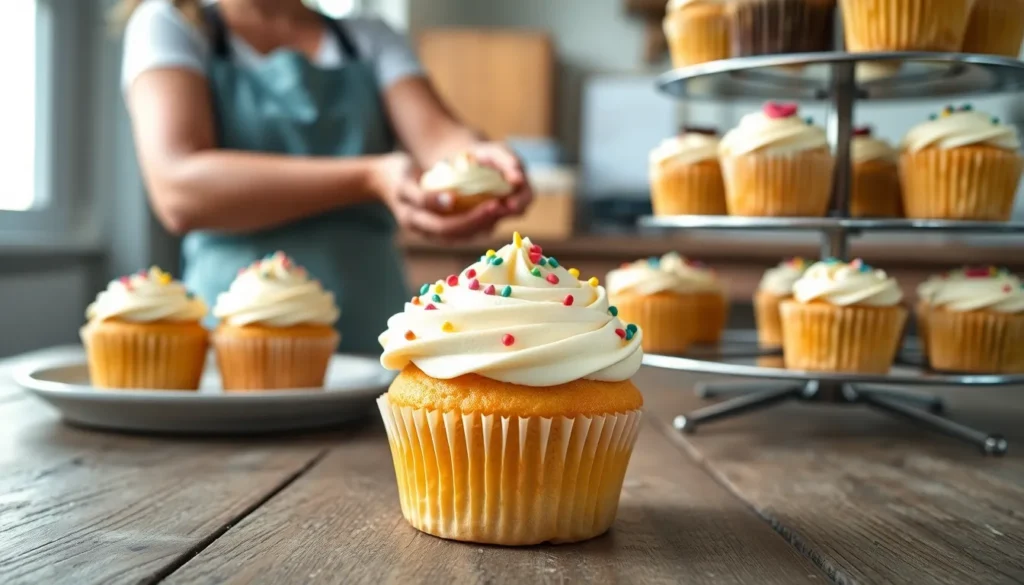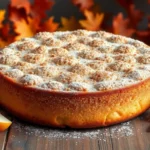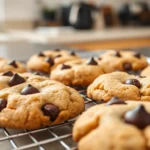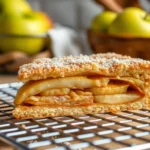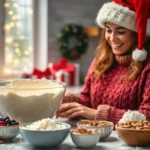There’s something truly magical about the perfect vanilla cupcake – it’s the foundation of countless celebrations and the dessert that never goes out of style. We’ve perfected this classic recipe to deliver incredibly moist, fluffy cupcakes with that rich vanilla flavor everyone craves.
What makes our vanilla cupcakes special isn’t just the tender crumb or the way they practically melt in your mouth. It’s the careful balance of premium vanilla extract, perfectly creamed butter, and the secret technique we’ll share that creates bakery-quality results every single time. These aren’t your average boxed-mix cupcakes – we’re talking about the kind that’ll have your friends begging for the recipe.
Whether you’re planning a birthday party, bringing treats to the office, or simply satisfying a sweet tooth, these vanilla cupcakes are your go-to solution. They’re surprisingly simple to make yet impressive enough to steal the show at any gathering.
Ingredients
These carefully selected ingredients work together to create cupcakes with exceptional texture and flavor. We’ve tested each component to ensure perfect results every time.
For the Cupcakes
- 1¾ cups all-purpose flour
- 1 cup granulated sugar
- ¼ cup unsalted butter, softened to room temperature
- 2 large eggs, room temperature
- 2½ teaspoons baking powder
- ½ teaspoon salt
- ⅔ cup whole milk, room temperature
- 2 teaspoons pure vanilla extract
- ⅓ cup vegetable oil
For the Vanilla Buttercream Frosting
- 1 cup unsalted butter, softened to room temperature
- 4 cups powdered sugar, sifted
- ¼ cup heavy cream
- 2 teaspoons pure vanilla extract
- ¼ teaspoon salt
Equipment Needed
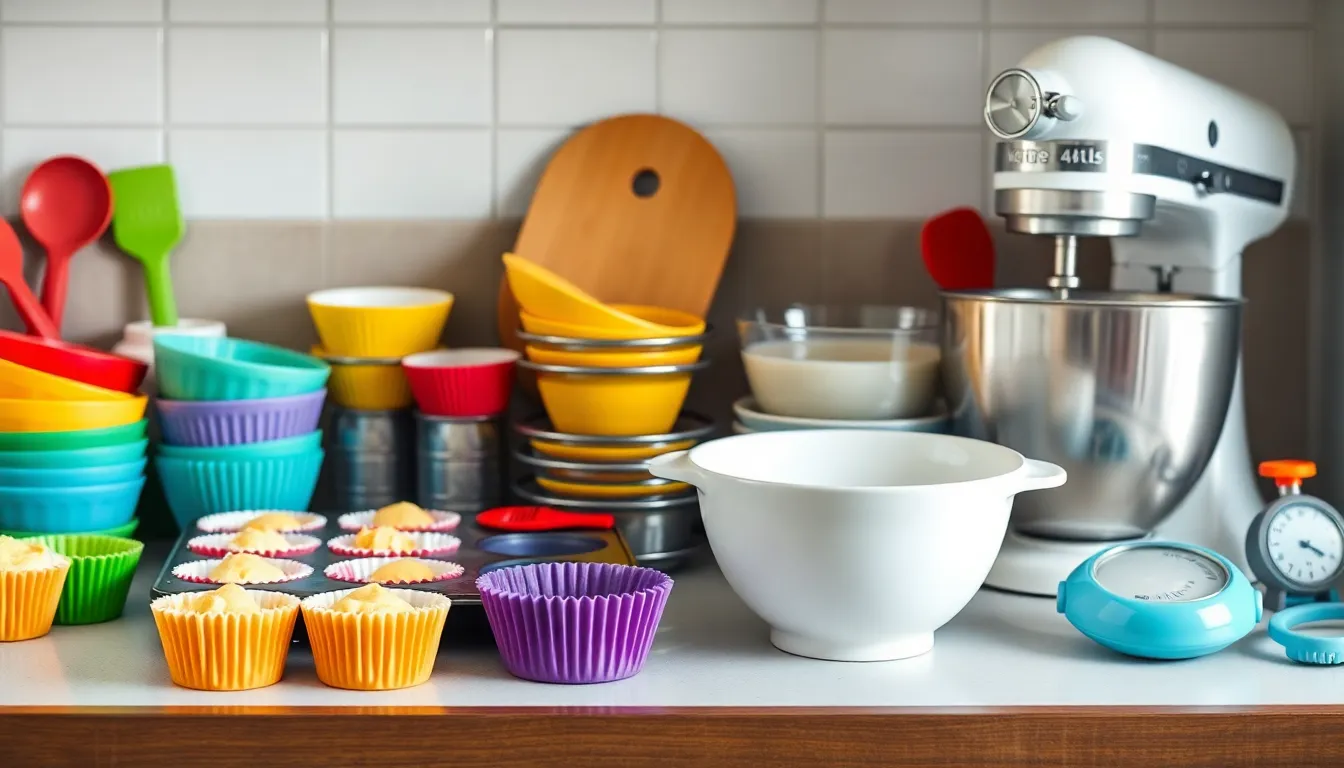
Before we jump into creating our perfect vanilla cupcakes, gathering the right equipment ensures smooth preparation and professional results. We recommend having these essential tools ready before starting the mixing process.
Essential Baking Equipment
Cupcake Baking Pan serves as the foundation for our baking success. We need a standard 12-cup muffin pan that distributes heat evenly throughout each cupcake cavity.
Cupcake Liners prevent sticking and create that bakery-perfect presentation we’re aiming for. Paper liners work beautifully, though silicone options offer reusable convenience.
Liquid Measuring Cups ensure accuracy when measuring our milk and oil. Glass or clear plastic versions allow us to check measurements at eye level for precision.
Dry Measuring Cups & Spoons handle our flour, sugar, and other dry ingredients. Nested sets provide the exact measurements our recipe demands.
Mixing Tools
Mixing Bowls in both large and medium sizes separate wet and dry ingredients before combining. Stainless steel or glass bowls work best for temperature control.
Electric Mixer transforms our butter and sugar into the light, fluffy base that creates tender cupcakes. Stand mixers offer hands-free convenience, while hand mixers provide excellent control.
Rubber Spatula scrapes bowl sides thoroughly and folds ingredients without overmixing. This tool ensures we capture every bit of our carefully measured ingredients.
Temperature and Timing Tools
Oven Thermometer verifies that our oven maintains the crucial 350°F temperature. Many home ovens run hot or cold, making this tool essential for consistent results.
Timer tracks our 15-18 minute baking window precisely. We recommend setting it for 15 minutes initially, then checking for doneness.
Optional Precision Tools
Electronic Scales provide weight measurements for ultimate accuracy. Professional bakers rely on weight rather than volume for consistent results.
Sieve aerates our flour and removes any lumps that could create dense spots in our cupcakes. This extra step elevates texture significantly.
Instructions

Follow these detailed steps to create bakery-quality vanilla cupcakes that will impress everyone. We’ve broken down the process into manageable sections to ensure perfect results every time.
Prep the Kitchen and Ingredients
Preheat your oven to 350°F (176°C) and line a 12-cup muffin pan with cupcake liners. Set all ingredients on the counter to reach room temperature, which takes about 30 minutes for butter and eggs. Measure out each ingredient using the proper measuring tools to ensure accuracy. We recommend using an oven thermometer to verify your oven temperature since many ovens run hot or cold.
Make the Cupcake Batter
Whisk together 1 1/4 cups all-purpose flour, 1 1/4 teaspoons baking powder, and 1/2 teaspoon salt in a medium bowl until well combined. Beat 1/2 cup softened unsalted butter and 3/4 cup granulated sugar in a large bowl using an electric mixer on medium speed for 2-3 minutes until light and fluffy. Add 2 large eggs one at a time, beating well after each addition, then mix in 2 teaspoons pure vanilla extract.
Combine 1/2 cup whole milk with 2 tablespoons vegetable oil in a small bowl. Alternate adding the flour mixture and milk mixture to the butter mixture, beginning and ending with flour. Mix on low speed until just combined after each addition to avoid overmixing. Scrape down the bowl sides with a rubber spatula to ensure even mixing.
Bake the Cupcakes
Fill each cupcake liner 2/3 to 3/4 full with batter using a large spoon or ice cream scoop for even distribution. Place the pan in the preheated oven and bake for 18-20 minutes until the tops spring back when lightly touched. Insert a toothpick into the center of one cupcake to test for doneness – it should come out clean or with just a few moist crumbs. Remove from oven and cool in the pan for 5 minutes before transferring to a wire rack to cool completely.
Prepare the Vanilla Buttercream Frosting
Beat 1/2 cup softened unsalted butter in a large bowl with an electric mixer on medium speed until creamy and smooth. Gradually add 3 cups powdered sugar, alternating with 3-4 tablespoons heavy cream, beating on low speed initially to prevent sugar clouds. Increase to medium-high speed and beat for 3-4 minutes until light and fluffy. Mix in 2 teaspoons pure vanilla extract and 1/4 teaspoon salt. Adjust consistency by adding more cream for thinner frosting or more powdered sugar for thicker frosting.
Assemble and Decorate
Ensure cupcakes are completely cooled before frosting to prevent melting. Transfer buttercream to a piping bag fitted with your desired tip, or simply use a knife to spread frosting. Pipe or spread frosting generously on top of each cupcake, creating swirls or peaks as desired. Add sprinkles, candies, or other decorative toppings immediately after frosting while it’s still soft. Store finished cupcakes covered at room temperature for up to 3 days or refrigerate for up to one week.
Storage Instructions

We know that properly storing your vanilla cupcakes ensures they maintain their delicious flavor and perfect texture for days after baking. Our storage recommendations vary based on your exact needs and the type of frosting used.
Room Temperature Storage
For short-term storage we recommend keeping your vanilla cupcakes in an airtight container at room temperature. Unfrosted cupcakes stay fresh for up to 1 day while those topped with stable frostings like our vanilla buttercream can be stored for 2 to 3 days. We suggest frosting your cupcakes right before serving for optimal results.
Refrigeration
When you need longer storage we advise refrigerating your cupcakes for 4 to 7 days depending on the frosting type. Cupcakes with whipped cream ganache or cream cheese frosting must always be refrigerated for food safety. Our buttercream-frosted cupcakes can stay at room temperature briefly but should be moved to the refrigerator if storing longer than a couple of days.
Freezing for Long-Term Storage
We recommend freezing unfrosted cupcakes for up to 3 months for the best quality. Wrap each cupcake individually in plastic wrap and place them in a resealable freezer bag to prevent freezer burn. Frosted cupcakes can also be frozen except those with whipped cream frosting which we suggest frosting after thawing.
Serving Temperature Guidelines
Always bring refrigerated or frozen cupcakes to room temperature before serving. This step ensures optimal texture and allows the full vanilla flavor to shine through.
Storage Duration Reference
| Storage Method | Duration | Special Notes |
|---|---|---|
| Room Temperature | 1-3 days | Use airtight container; ideal for stable frostings |
| Refrigerator | 4-7 days | Required for cream-based frostings |
| Freezer | Up to 3 months | Wrap individually; thaw completely before serving |
Make-Ahead Tips

We understand that busy schedules often require advance preparation, and these vanilla cupcakes adapt beautifully to make-ahead strategies. Our experience shows that proper planning enhances both convenience and flavor development.
Optimal Storage Durations
| Storage Method | Duration | Best For |
|---|---|---|
| Room Temperature | 3-4 days | Mild weather conditions |
| Refrigerated | Up to 3 days | Cream-based frostings |
| Frozen | 3+ months | Long-term storage |
Room Temperature Storage
We recommend storing unfrosted vanilla cupcakes at room temperature in airtight containers for up to 3 days. During mild weather conditions, these cupcakes maintain their moisture and texture for 4 days on the counter. This method works particularly well when we plan to frost them within this timeframe.
Refrigeration Guidelines
Refrigeration becomes necessary when cupcakes won’t be consumed within the initial 3-day window. We store them in the refrigerator for up to 3 additional days, always ensuring they return to room temperature before serving. This temperature adjustment allows the flavors to fully develop and the texture to soften naturally.
Freezer Storage Strategy
Long-term storage requires freezing, which we recommend for periods exceeding 3 to 4 days. We wrap individual cupcakes tightly to prevent freezer burn and maintain optimal quality. Frozen vanilla cupcakes thaw beautifully at room temperature while preserving their original moisture content.
Ingredient Preparation Advantages
We achieve superior results by preparing ingredients ahead of time. Room temperature eggs and soft butter create better mixing conditions and enhanced texture development. This advance preparation streamlines our baking process significantly.
Frosting Considerations
Our buttercream frosting requires room temperature cream for proper emulsification and smooth consistency. We can alternatively use whipped cream as a topping, especially when planning to freeze the finished cupcakes. This flexibility accommodates various storage and serving timelines.
Serving Temperature Guidelines
We always bring refrigerated cupcakes to room temperature before serving to optimize taste and texture. Frozen cupcakes thaw naturally at room temperature, requiring no special equipment or rushed warming methods. This simple step ensures our vanilla cupcakes deliver their intended flavor profile and delightful texture.
Serving Suggestions
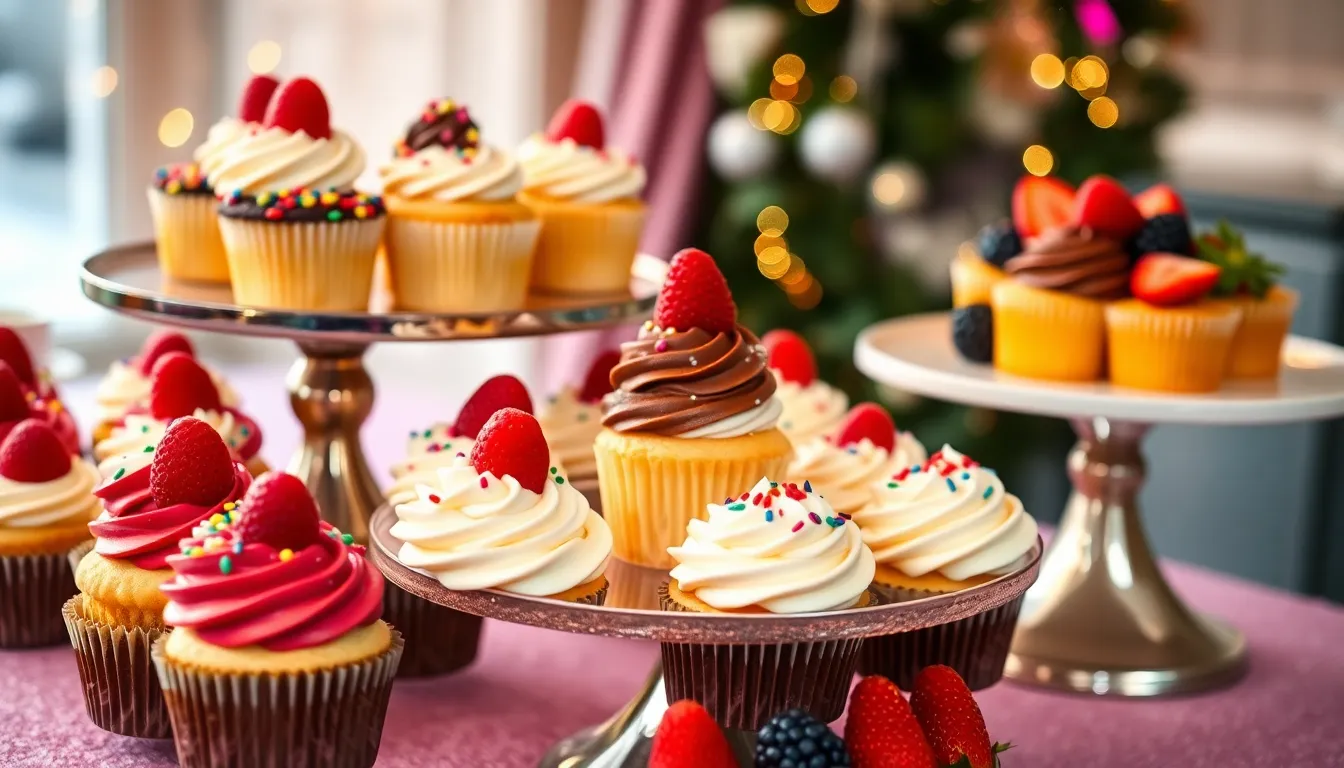
Our perfectly crafted vanilla cupcakes deserve presentation that matches their exceptional quality. We recommend serving these treats at room temperature to ensure the fullest flavor profile and optimal texture experience for your guests.
Traditional Frosting Pairings
Vanilla buttercream remains our top recommendation for these cupcakes, creating a harmonious flavor combination that enhances rather than overwhelms the delicate vanilla base. Chocolate fudge frosting offers a delightful contrast that appeals to those seeking richer indulgence. Cream cheese frosting provides tangy balance that complements the sweet vanilla notes beautifully.
Creative Topping Options
Colorful sprinkles transform ordinary cupcakes into festive celebration centerpieces perfect for birthdays and special occasions. Edible glitter adds sophisticated sparkle that elevates the visual appeal for elegant gatherings. Fresh berries bring natural sweetness and vibrant color while providing textural contrast to the soft crumb.
Presentation Styles
Individual plating works beautifully for intimate dinner parties where each guest receives personal attention to their dessert experience. Dessert table arrangements allow guests to select their preferred cupcake while creating an impressive visual display. Tiered stands maximize vertical space while showcasing the cupcakes’ decorative appeal.
Portion Considerations
Standard-sized cupcakes provide satisfying individual servings that work perfectly for most occasions without overwhelming guests. Mini cupcakes offer bite-sized alternatives that accommodate larger groups while allowing people to sample multiple flavors or simply enjoy lighter portions.
Serving Temperature Guidelines
| Storage Method | Serving Temperature | Time to Room Temperature |
|---|---|---|
| Room Temperature Storage | Serve immediately | 0 minutes |
| Refrigerated | Remove 30-45 minutes before serving | 30-45 minutes |
| Frozen | Thaw 2-3 hours at room temperature | 2-3 hours |
Special Occasion Adaptations
Birthday celebrations benefit from coordinated color schemes using matching frosting and sprinkle combinations. Office gatherings work best with minimal mess toppings that maintain professional presentation. Wedding events call for elegant decorations like pearl dust or delicate fondant accents that complement the ceremony’s sophistication.
Recipe Variations
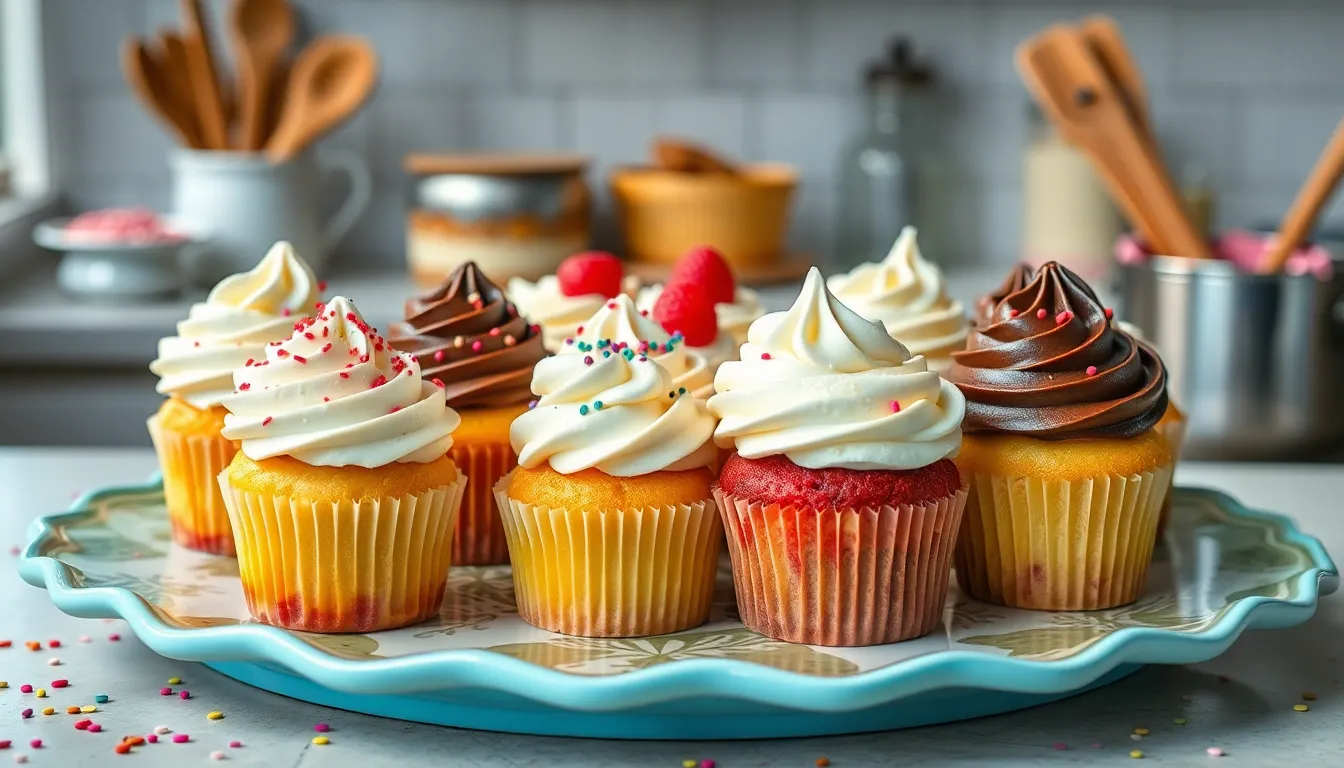
Our master vanilla cupcake recipe serves as the perfect foundation for countless delicious variations. We can transform one basic batter into multiple flavors by dividing it and adding different ingredients to each portion.
Flavor Variations
Classic Vanilla remains our most popular choice, featuring pure vanilla extract that delivers the traditional flavor everyone loves. The clean vanilla taste pairs beautifully with any frosting and works for every occasion.
Chocolate Cupcakes emerge when we add cocoa powder or melted chocolate to our vanilla base. We recommend using 3 tablespoons of unsweetened cocoa powder per batch for rich chocolate flavor without overwhelming sweetness.
Strawberry Cupcakes bring fruity brightness to our vanilla foundation. We incorporate strawberry puree or finely chopped fresh strawberries into the batter, creating natural fruit flavor and beautiful pink color throughout.
Red Velvet Cupcakes combine cocoa powder with red food coloring for that distinctive appearance and subtle chocolate taste. We use 2 tablespoons of cocoa powder and 1-2 teaspoons of red gel food coloring to achieve the classic red velvet look.
Frosting Alternatives
Vanilla Buttercream stands as our classic topping choice, made with butter, powdered sugar, and vanilla extract. This traditional frosting complements every cupcake flavor and provides smooth, pipeable consistency.
Fudgy Chocolate Frosting offers rich intensity that chocolate lovers crave. We create this decadent option using cocoa powder, butter, and powdered sugar for deep chocolate flavor that pairs especially well with vanilla cupcakes.
Strawberry Buttercream delivers sweet fruity taste using freeze-dried strawberries or cooked strawberry puree. This pink frosting adds natural berry flavor and creates beautiful color contrast against vanilla cupcakes.
Pumpkin Spice Buttercream brings fall flavors to our cupcakes with warm spices like cinnamon, nutmeg, and cloves. We blend these spices with traditional buttercream ingredients for seasonal appeal.
Chocolate Fudge Buttercream provides the ultimate chocolate experience with its rich, dark chocolate flavor. This frosting works perfectly for birthday cupcakes and special celebrations when we want maximum chocolate impact.
Troubleshooting Tips
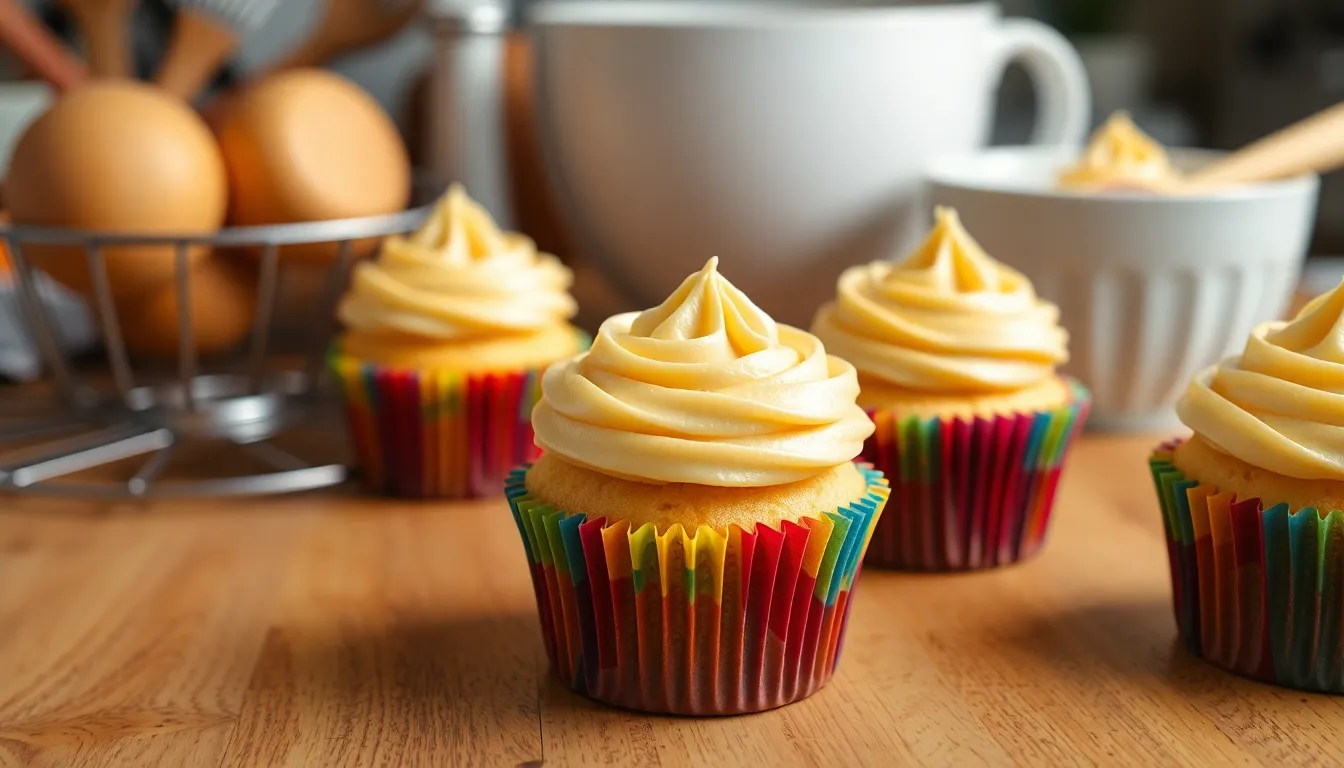
Even experienced bakers encounter challenges when making vanilla cupcakes. We’ve compiled answers to the most common issues based on proven baking techniques and testing results.
Preventing Cupcake Explosions
Exploding cupcakes occur when ovens run too hot or recipes contain excessive leavening agents. We recommend using an oven thermometer to verify actual temperatures since many ovens run 25-50 degrees off their display settings. Following recipe measurements precisely for baking powder and baking soda prevents chemical reactions that cause cupcakes to burst during baking.
Fixing Sinking and Shrinking Issues
Sinking cupcakes result from three primary causes: overmixing the batter, using too much leavening agent, or incorrect baking temperatures. We suggest mixing ingredients gently until just combined rather than beating vigorously. Checking leavening agent measurements against the recipe ensures proper rise without collapse. Avoid opening the oven door during the first 15 minutes of baking as temperature fluctuations cause structural failure.
Managing Cupcake Overflow
Overfilled cupcake liners create messy results and uneven baking. We fill our liners between halfway and three-quarters full to allow proper expansion without spillover. This measurement typically equals about 3 tablespoons of batter per standard cupcake liner.
Temperature Control for Ingredients
Cold ingredients prevent proper mixing and create dense textures in finished cupcakes. We bring all ingredients to room temperature 1-2 hours before baking. Butter should yield slightly to pressure while eggs and milk should feel neutral to touch rather than cold.
Preventing Add-In Settlement
Heavy mix-ins like chocolate chips and sprinkles sink to cupcake bottoms without proper preparation. We coat add-ins with a light dusting of flour before folding them into batter. This technique creates grip that suspends ingredients throughout the cupcake during baking.
Achieving Proper Texture
Dense or heavy cupcakes often result from compressed flour that hasn’t been properly aerated. We sift flour thoroughly before measuring to incorporate air and create lighter textures. This step removes lumps and ensures even distribution throughout the batter.
| Common Problem | Primary Cause | Solution | Prevention Time |
|---|---|---|---|
| Exploding cupcakes | Overheated oven/excess leavening | Use oven thermometer/follow recipe | 5 minutes setup |
| Sinking cupcakes | Overmixing/temperature issues | Gentle mixing/avoid door opening | Throughout process |
| Overflowing liners | Too much batter | Fill 1/2 to 3/4 full | 30 seconds per cupcake |
| Dense texture | Cold ingredients | Room temperature prep | 1-2 hours advance |
| Settling add-ins | Heavy ingredients | Flour coating technique | 2 minutes prep |
| Heavy crumb | Compressed flour | Thorough sifting | 3 minutes prep |
Conclusion
We’ve shown you everything needed to master the art of vanilla cupcake baking. From selecting premium ingredients to troubleshooting common issues our comprehensive guide ensures bakery-quality results every time.
These aren’t just ordinary cupcakes – they’re your gateway to countless celebrations and sweet memories. With proper storage techniques and creative variations you’ll always have the perfect dessert ready for any occasion.
The beauty of this recipe lies in its versatility and reliability. Whether you’re decorating for a birthday party or trying new flavor combinations you now have the foundation for cupcake success.
Start baking today and discover why homemade vanilla cupcakes will always outshine store-bought alternatives. Your kitchen is about to become everyone’s favorite destination.
Frequently Asked Questions
What makes these vanilla cupcakes better than boxed mixes?
These homemade vanilla cupcakes use premium ingredients like pure vanilla extract, whole milk, and unsalted butter, creating a richer flavor and moister texture. The special technique balances wet and dry ingredients perfectly, resulting in bakery-quality cupcakes that are far superior to artificial-tasting boxed mixes.
How long do vanilla cupcakes stay fresh?
Unfrosted cupcakes stay fresh at room temperature for up to 3 days. Frosted cupcakes with stable buttercream can be refrigerated for 2-3 days, while those with cream-based frostings should be eaten within 4-7 days when refrigerated. For longer storage, freeze unfrosted cupcakes for up to 3 months.
What equipment do I need to make perfect vanilla cupcakes?
Essential equipment includes a 12-cup muffin pan, cupcake liners, measuring cups, mixing bowls, an electric mixer, rubber spatula, oven thermometer, and timer. Optional tools like electronic scales and a sieve can improve precision and texture, but the basic equipment will produce excellent results.
Can I make vanilla cupcakes ahead of time?
Yes! Unfrosted cupcakes can be made 1-2 days ahead and stored at room temperature, or frozen for up to 3 months. Buttercream frosting can be prepared in advance and refrigerated. For best results, bring everything to room temperature before assembling and serving.
What’s the best way to store frosted cupcakes?
Store frosted cupcakes in an airtight container in the refrigerator for 4-7 days, depending on the frosting type. Buttercream-frosted cupcakes can stay at room temperature for 2-3 days. Always cover them properly to prevent drying out and maintain freshness.
How do I prevent cupcakes from sinking or overflowing?
Use precise measurements and avoid overmixing the batter. Fill cupcake liners only 2/3 full, ensure your oven temperature is accurate with a thermometer, and use room temperature ingredients for better mixing. Don’t open the oven door during the first 15 minutes of baking.
What frosting pairs best with vanilla cupcakes?
Classic vanilla buttercream is the traditional choice, but chocolate fudge frosting and cream cheese frosting are also popular. For variety, try strawberry buttercream, pumpkin spice buttercream, or simple powdered sugar dusting. Choose based on your occasion and flavor preferences.
Can I make different flavored cupcakes using this vanilla recipe?
Absolutely! The vanilla base recipe adapts easily to chocolate (add cocoa powder), strawberry (add puree and extract), or red velvet (add cocoa and food coloring). Adjust liquid ingredients slightly when adding flavoring components to maintain proper batter consistency.

